ESP BMW MOTORRAD G 650 GS 2010 Rider's Manual (in English)
[x] Cancel search | Manufacturer: BMW MOTORRAD, Model Year: 2010, Model line: G 650 GS, Model: BMW MOTORRAD G 650 GS 2010Pages: 136, PDF Size: 1.73 MB
Page 38 of 136
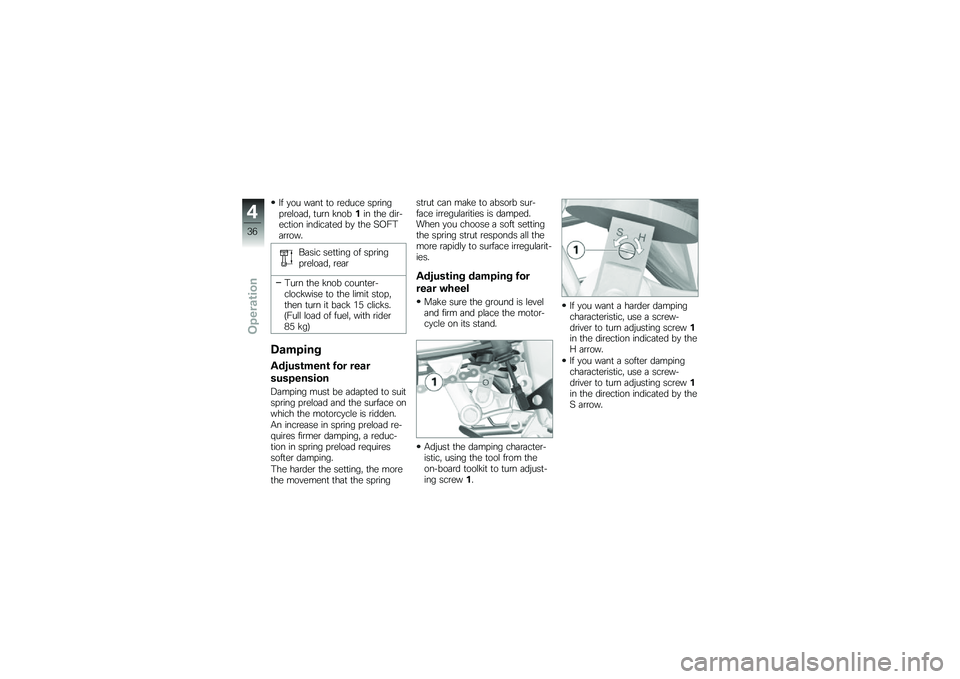
If you want to reduce springpreload, turn knob1in the dir-ection indicated by the SOFTarrow.
Basic setting of springpreload, rear
Turn the knob counter-clockwise to the limit stop,then turn it back 15 clicks.(Full load of fuel, with rider85 kg)
Damping
Adjustment for rear
suspension
Damping must be adapted to suitspring preload and the surface onwhich the motorcycle is ridden.
An increase in spring preload re-quires firmer damping, a reduc-tion in spring preload requiressofter damping.
The harder the setting, the morethe movement that the spring
strut can make to absorb sur-face irregularities is damped.When you choose a soft settingthe spring strut responds all themore rapidly to surface irregularit-ies.
Adjusting damping for
rear wheel
Make sure the ground is leveland firm and place the motor-cycle on its stand.
Adjust the damping character-istic, using the tool from theon-board toolkit to turn adjust-ing screw1.
If you want a harder dampingcharacteristic, use a screw-driver to turn adjusting screw1in the direction indicated by theH arrow.
If you want a softer dampingcharacteristic, use a screw-driver to turn adjusting screw1in the direction indicated by theS arrow.
4
36
zOperation
Page 44 of 136

Safety instructions
Rider's equipment
Do not ride without the correctclothing. Always wear:
Helmet
Motorcycling jacket andtrousers
Gloves
Boots
This applies even to short jour-neys, and to every season ofthe year. Your authorised BMWMotorrad dealer will be glad toadvise you on the correct cloth-ing for every purpose.
Correct loading
Overloading and imbal-anced loads can adverselyaffect the motorcycle's handling.
Do not exceed the permissiblegross weight and be sure tocomply with the instructions onloading.
Set spring preload, dampingcharacteristic and tyre pres-sures to suit total weight.
with caseOA
Ensure that the case volumeson the left and right are equal.
Make sure that the weight isuniformly distributed betweenright and left.
Pack heavy items at the bot-tom and toward the inboardside.
Note the maximum permissiblepayload and the speed limitfor riding with cases fitted, asstated on the label inside thecase.
with topcaseOA
Note the maximum permissiblepayload and the speed limit forriding with topcase fitted, asstated on the label inside thetopcase.
with tank rucksackOA
Note the maximum permissiblepayload of the tank rucksackand the speed limit for ridingwith a tank rucksack on themotorcycle.
Payload of tank rucksack
max 5 kg
Maximum permissiblespeed for riding with thetank rucksack fitted to the mo-torcycle
max 130 km/h
Speed
If you ride at high speed, alwaysbear in mind that various bound-ary conditions can adversely af-fect the handling of your motor-cycle:
5
42
zRiding
Page 48 of 136

If an indicator showing an ABSfault appears when ABS self-dia-gnosis completes:
You can continue to ride. Bearin mind that the ABS functionis not available.
Have the fault rectified asquickly as possible by aspecialist workshop, preferablyan authorised BMW Motorraddealer.
Running in
The first 1000 km
While running in the motor-cycle, vary the throttle openingand engine-speed range fre-quently.
Try to do most of your rid-ing during this initial period ontwisting, fairly hilly roads, avoid-ing high-speed main roads andhighways if possible.
Exceeding the specified en-gine speeds while runningin will lead to increased enginewear.
Keep to the specified enginespeeds for running in.
Do not exceed the rpm limitsrecommended for running in.
Running-in speed
max 5000 min-1(for the first1000 km)
No full-load acceleration.
Avoid low engine speeds at fullload.
Do not omit the first inspectionafter 500 - 1200 km.
Brake pads
New brake pads have to beddown before they can achievetheir optimum friction levels. Youcan compensate for this initial re-duction in braking efficiency by
exerting greater pressure on thelevers.
New brake pads can ex-tend stopping distance by asignificant margin.
Apply the brakes in good time.
Tyres
New tyres have a smooth sur-face. This must be roughened byriding in a restrained manner atvarious heel angles until the tyresare run in. This running in pro-cedure is essential if the tyres areto achieve maximum grip.
Tyres do not have their fullgrip when new and thereis a risk of accidents at extremeangles of heel.
Avoid extreme angles of heel.
5
46
zRiding
Page 49 of 136
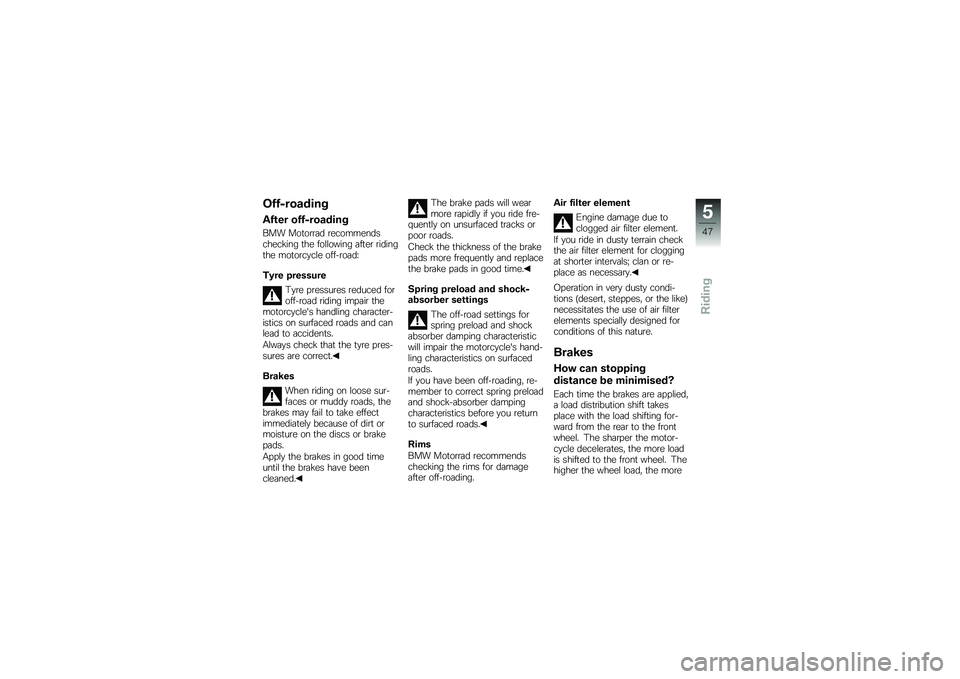
Off-roading
After off-roading
BMW Motorrad recommendschecking the following after ridingthe motorcycle off-road:
Tyre pressure
Tyre pressures reduced foroff-road riding impair themotorcycle's handling character-istics on surfaced roads and canlead to accidents.
Always check that the tyre pres-sures are correct.
Brakes
When riding on loose sur-faces or muddy roads, thebrakes may fail to take effectimmediately because of dirt ormoisture on the discs or brakepads.
Apply the brakes in good timeuntil the brakes have beencleaned.
The brake pads will wearmore rapidly if you ride fre-quently on unsurfaced tracks orpoor roads.
Check the thickness of the brakepads more frequently and replacethe brake pads in good time.
Spring preload and shock-absorber settings
The off-road settings forspring preload and shockabsorber damping characteristicwill impair the motorcycle's hand-ling characteristics on surfacedroads.
If you have been off-roading, re-member to correct spring preloadand shock-absorber dampingcharacteristics before you returnto surfaced roads.
Rims
BMW Motorrad recommendschecking the rims for damageafter off-roading.
Air filter element
Engine damage due toclogged air filter element.
If you ride in dusty terrain checkthe air filter element for cloggingat shorter intervals; clan or re-place as necessary.
Operation in very dusty condi-tions (desert, steppes, or the like)necessitates the use of air filterelements specially designed forconditions of this nature.
Brakes
How can stopping
distance be minimised?
Each time the brakes are applied,a load distribution shift takesplace with the load shifting for-ward from the rear to the frontwheel. The sharper the motor-cycle decelerates, the more loadis shifted to the front wheel. Thehigher the wheel load, the more
5
47
zRiding
Page 56 of 136
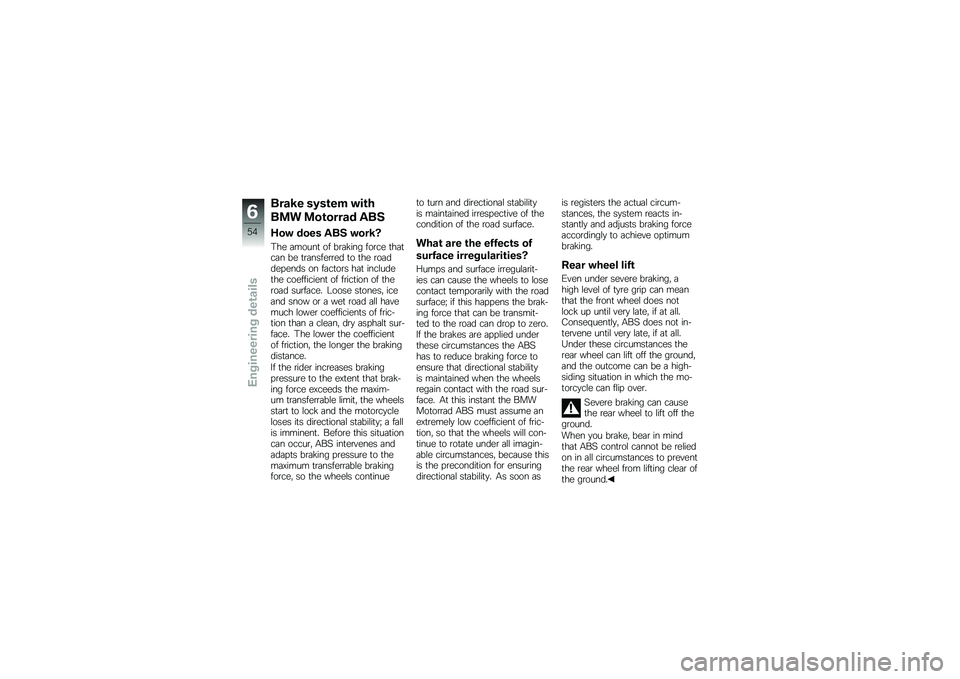
Brake system with
BMW Motorrad ABS
How does ABS work?
The amount of braking force thatcan be transferred to the roaddepends on factors hat includethe coefficient of friction of theroad surface. Loose stones, iceand snow or a wet road all havemuch lower coefficients of fric-tion than a clean, dry asphalt sur-face. The lower the coefficientof friction, the longer the brakingdistance.
If the rider increases brakingpressure to the extent that brak-ing force exceeds the maxim-um transferrable limit, the wheelsstart to lock and the motorcycleloses its directional stability; a fallis imminent. Before this situationcan occur, ABS intervenes andadapts braking pressure to themaximum transferrable brakingforce, so the wheels continue
to turn and directional stabilityis maintained irrespective of thecondition of the road surface.
What are the effects of
surface irregularities?
Humps and surface irregularit-ies can cause the wheels to losecontact temporarily with the roadsurface; if this happens the brak-ing force that can be transmit-ted to the road can drop to zero.If the brakes are applied underthese circumstances the ABShas to reduce braking force toensure that directional stabilityis maintained when the wheelsregain contact with the road sur-face. At this instant the BMWMotorrad ABS must assume anextremely low coefficient of fric-tion, so that the wheels will con-tinue to rotate under all imagin-able circumstances, because thisis the precondition for ensuringdirectional stability. As soon as
is registers the actual circum-stances, the system reacts in-stantly and adjusts braking forceaccordingly to achieve optimumbraking.
Rear wheel lift
Even under severe braking, ahigh level of tyre grip can meanthat the front wheel does notlock up until very late, if at all.Consequently, ABS does not in-tervene until very late, if at all.Under these circumstances therear wheel can lift off the ground,and the outcome can be a high-siding situation in which the mo-torcycle can flip over.
Severe braking can causethe rear wheel to lift off theground.
When you brake, bear in mindthat ABS control cannot be reliedon in all circumstances to preventthe rear wheel from lifting clear ofthe ground.
6
54
zEngineering details
Page 70 of 136
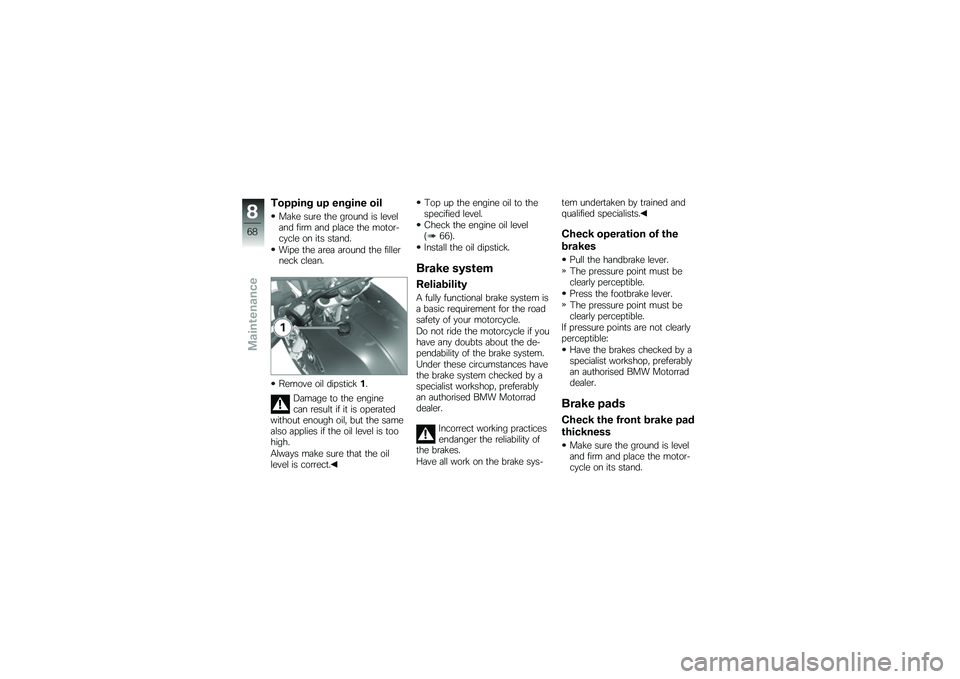
Topping up engine oil
Make sure the ground is leveland firm and place the motor-cycle on its stand.
Wipe the area around the fillerneck clean.
Remove oil dipstick1.
Damage to the enginecan result if it is operatedwithout enough oil, but the samealso applies if the oil level is toohigh.
Always make sure that the oillevel is correct.
Top up the engine oil to thespecified level.
Check the engine oil level(66).
Install the oil dipstick.
Brake system
Reliability
A fully functional brake system isa basic requirement for the roadsafety of your motorcycle.
Do not ride the motorcycle if youhave any doubts about the de-pendability of the brake system.
Under these circumstances havethe brake system checked by aspecialist workshop, preferablyan authorised BMW Motorraddealer.
Incorrect working practicesendanger the reliability ofthe brakes.
Have all work on the brake sys-
tem undertaken by trained andqualified specialists.
Check operation of the
brakes
Pull the handbrake lever.
The pressure point must beclearly perceptible.
Press the footbrake lever.
The pressure point must beclearly perceptible.
If pressure points are not clearlyperceptible:
Have the brakes checked by aspecialist workshop, preferablyan authorised BMW Motorraddealer.
Brake pads
Check the front brake pad
thickness
Make sure the ground is leveland firm and place the motor-cycle on its stand.
8
68
zMaintenance
Page 71 of 136
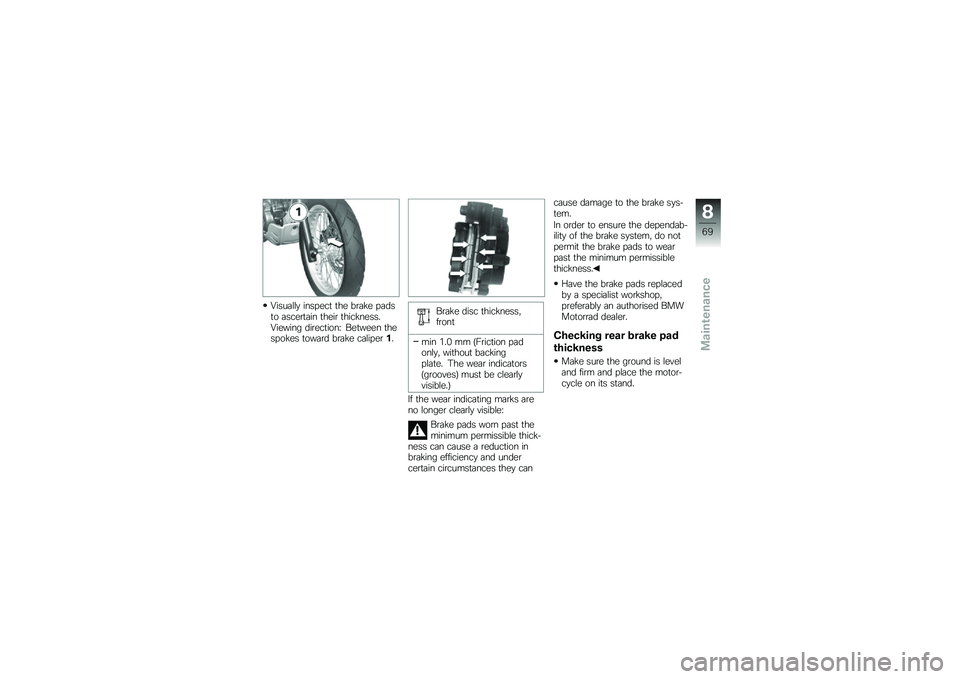
Visually inspect the brake padsto ascertain their thickness.Viewing direction: Between thespokes toward brake caliper1.
Brake disc thickness,front
min 1.0 mm (Friction padonly, without backingplate. The wear indicators(grooves) must be clearlyvisible.)
If the wear indicating marks areno longer clearly visible:
Brake pads worn past theminimum permissible thick-ness can cause a reduction inbraking efficiency and undercertain circumstances they can
cause damage to the brake sys-tem.
In order to ensure the dependab-ility of the brake system, do notpermit the brake pads to wearpast the minimum permissiblethickness.
Have the brake pads replacedby a specialist workshop,preferably an authorised BMWMotorrad dealer.
Checking rear brake pad
thickness
Make sure the ground is leveland firm and place the motor-cycle on its stand.
8
69
zMaintenance
Page 83 of 136

Remove quick-release axle5,supporting the rear wheel asyou do so.
Roll the rear wheel back untilit is clear of the swinging arm,while holding the brake caliperon the left-hand side.
The sprocket and thespacer sleeves on leftand right are loose fits in thewheel. Make sure that theseparts are not damaged or lost onremoval.
Install the rear wheel
Threaded fasteners nottightened to the specifiedtorque can work loose or theirthreads can suffer damage.
Always have the security of thefasteners checked by a specialistworkshop, preferably an author-ised BMW Motorrad dealer.
Make sure that the brake cal-iper moves on guide6.
Roll the rear wheel into theswinging arm, making sure thatthe brake disc passes betweenthe brake pads.
Lift the rear wheel and workquick-release axle5throughthe swinging arm, the brakecaliper and the rear wheel.
8
81
zMaintenance
Page 87 of 136

nical data". The figures in thegraphic correspond to the fusenumbers.
Close the fuse cover.
The latch engages with anaudible click.
Installing seat (39).
Bulbs
Notes
A defective bulb placesyour safety at risk becauseit is easier for other users tooversee the motorcycle.
Replace defective bulbs assoon as possible; always carry acomplete set of spare bulbs ifpossible.
The bulb is pressurised andcan cause injury if dam-aged.
Wear protective goggles andgloves when changing bulbs.
The types of bulb fitted toyour motorcycle are listedin the section entitled "Technicaldata".
Do not touch the glass ofnew bulbs with your fingers.Use a clean, dry cloth to holdthe bulbs when handling them.Dirt deposits, in particular oil andgrease, interfere with heat radi-ation from the bulb. This leadsto overheating and shortens thebulb's operating life.
Replacing low-beam and
high-beam headlight bulb
If it is not standing firmly,the motorcycle could topplein the course of the operationsdescribed below.
Always make sure that themotorcycle is stable and firmlysupported.
Make sure the ground is leveland firm and place the motor-cycle on its stand.
Switch off the ignition.
Disconnect plug1.
Remove rubber cap2.
8
85
zMaintenance
Page 104 of 136
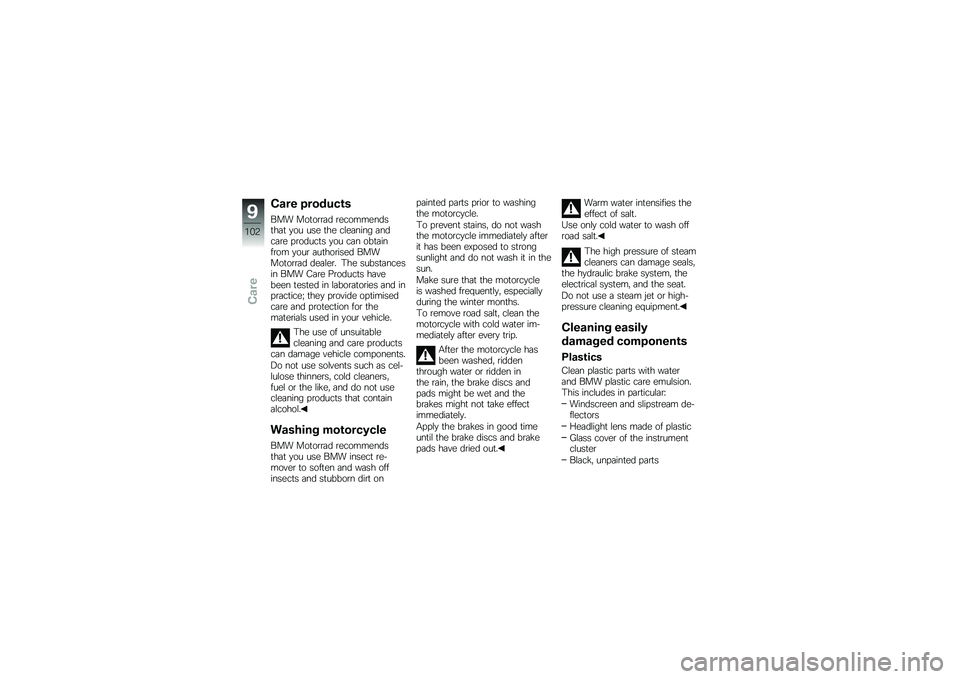
Care products
BMW Motorrad recommendsthat you use the cleaning andcare products you can obtainfrom your authorised BMWMotorrad dealer. The substancesin BMW Care Products havebeen tested in laboratories and inpractice; they provide optimisedcare and protection for thematerials used in your vehicle.
The use of unsuitablecleaning and care productscan damage vehicle components.
Do not use solvents such as cel-lulose thinners, cold cleaners,fuel or the like, and do not usecleaning products that containalcohol.
Washing motorcycle
BMW Motorrad recommendsthat you use BMW insect re-mover to soften and wash offinsects and stubborn dirt on
painted parts prior to washingthe motorcycle.
To prevent stains, do not washthe motorcycle immediately afterit has been exposed to strongsunlight and do not wash it in thesun.
Make sure that the motorcycleis washed frequently, especiallyduring the winter months.
To remove road salt, clean themotorcycle with cold water im-mediately after every trip.
After the motorcycle hasbeen washed, riddenthrough water or ridden inthe rain, the brake discs andpads might be wet and thebrakes might not take effectimmediately.
Apply the brakes in good timeuntil the brake discs and brakepads have dried out.
Warm water intensifies theeffect of salt.
Use only cold water to wash offroad salt.
The high pressure of steamcleaners can damage seals,the hydraulic brake system, theelectrical system, and the seat.
Do not use a steam jet or high-pressure cleaning equipment.
Cleaning easily
damaged components
Plastics
Clean plastic parts with waterand BMW plastic care emulsion.This includes in particular:
Windscreen and slipstream de-flectors
Headlight lens made of plastic
Glass cover of the instrumentcluster
Black, unpainted parts
9
102
zCare